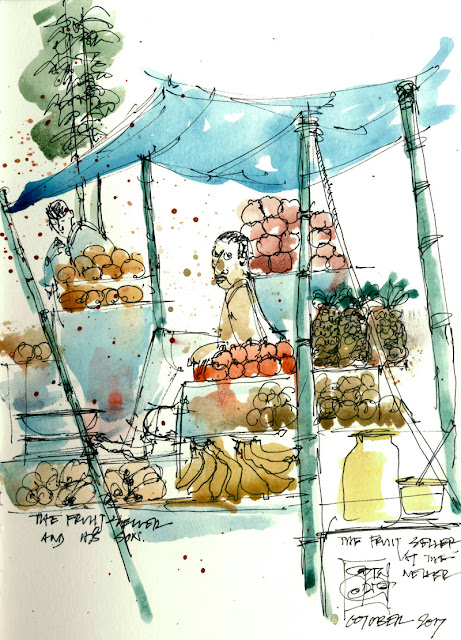
[Guest post by Tapas Mitra in Bhopal]
Street
vendors and service providers form a significant visual aspect of the
Indian urban landscape. The diversity of trades and services provided is
immense and though the entire sector is technically classified under
‘urban informal’, they provide significant contribution to the country’s
economy. Seen in residential areas, central business districts and along
movement corridors,
the vendors are primarily independent traders and/or specialised in
certain services. Each holiday or ‘absence’ from work cost them their
day’s income. The government tries to mainstream this sector but the
nature of the ‘informal’ cannot perhaps be captured within the formal
economic order.
The
fruit seller (top) sources the fruit early in the morning and operates
from his makeshift shop the whole day. His son helps by arranging the
fruit and putting them in bags or packets for the customers. India is
trying hard to reach the state of being free of plastic. These days we
see more and more paper packets coming into use.
 |
| The Chai stall |
It is called the tea stall or the ‘Chai’ stall in
India and its presence is almost everywhere (above). As is the ubiquitous holy
man. The gas cylinder is kept casually at the front of the shop.
Accidents due to this are quite common. The body language of the tea
seller boy in the sketch is full of his entrepreneurial persona.

The
dress forms or the mannequins (above) are kept outside or hung from
bamboo poles of this stretch in a locality called ‘Bairagarh’ in Bhopal,
lived in predominantly by the Sindhi community who settled here after
the partition of 1947. They are a business community dealing in a wide
range of products. The figure of the holy man makes for a striking
visual amidst the mannequins. This sketch was made during Diwali or
Deepavali, the Hindu festival of light celebrated all over the
country at this time of the year.
 |
| The florist |
The florist shop (above) does good business during these
festive days. Note the garland stitching cum bouquet artist boy at the
back of the shop on the street.
 |
| The Panipuri vendor |
The Panipuri vendor sells perhaps the most popular
street snack in India. Ingredients are fried hollow balls with extremely
thin crust made of flour to be filled in with a mix of mashed potato,
boiled chickpeas, coriander leaves and spices. The ball is then filled
with tamarind water and served by hand. How a panipuri shell is burst
with the thumb of the left hand is sketched. The panipuri has diverse
local variations and as many as, if not more than, six names depending in
which part of the country you are in.
 |
| Coconut water vendor |
The tender coconut water seller perhaps cannot compete with
the global soft drink brands but the vendor is a common sight on Indian
streets.
 |
| The milkman |
Every
morning the milkman delivers milk at the door steps of his customers.
In the sketch, he has 20 and 10 litre containers tied to the bike on
both sides. The balancing act is worth a glance.
 |
| The boot polishwala |
The
‘boot polishwala’ as he is commonly referred to, is the man on the
street, as seen in this modest kiosk in the sketch, who not only polishes,
but also repairs and even designs new ones. He is a very specialised
service provider. The floaters (sandals) seen in the foreground are
meant for customers who take their shoes off while they are being
polished or repaired.

The
man who presses clothes in residential neighbourhoods use charcoal to
heat the iron (above). It is heavy (3-5 kgs) and can be operated only by
specialists. Details of the iron and the charcoal chamber are shown in
the sketch above.

The
last sketch shows the inner court of an old palace, which is restored
and taken over by the government to host fairs on various occasions. The
one hosted during Diwali is called ‘Deepotsav’ or ‘festival of light’.
Here the street comes into a royal palace of another era. I have sketched
areas where brass figurines of Hindu gods, goddesses and nymphs are
being sold along with lamps of various shapes and forms and sculptural
ideas.
Tapas Mitra is a self-taught artist who teaches
architecture and urban design at the School of Planning and Architecture
in Bhopal, India. He lectured at the 8th Urban Sketchers Symposium in
Chicago. Read his previous guest post ‘Scenes from the departure lounge’. He lives and works in Bhopal with his wife and daughter.
Share
Recent Posts
Check Out the Brand New USk Shop
Guess what? Our Urban Sketchers Shop just leveled up with some seriously...
Read MoreOpen Call for Emerging Storytellers!
Are you aged between 18 and 25? And are you passionate...
Read MoreInternational Urban Sketchers Week 2024!
We are excited to share with you that we have registered a...
Read MoreDrawing Attention March 2024
Drawing Attention, the official zine of the Urban Sketchers organization, communicates...
Read More